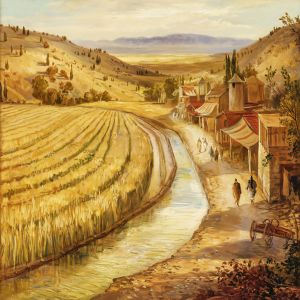Alun-Tar: Difference between revisions
No edit summary |
No edit summary |
||
| (9 intermediate revisions by the same user not shown) | |||
| Line 1: | Line 1: | ||
{{ | {{Settlements in the Sanctuary Vale Infobox | ||
|Name=Alun-Tar | |Name=Alun-Tar | ||
|Image=[[File: | |Image=[[File:Alun-Tar.jpg|center|frameless]] | ||
|Type= | |Type=Agricultural Settlement | ||
|Location=Central [[Sanctuary Vale]], midway along the Va-Djes Road | |Location=Central [[Sanctuary Vale]], midway along the Va-Djes Road | ||
|Realm=[[Terasil]] | |Realm=[[Terasil]] | ||
| | |Region=Sanctuary Vale | ||
|Significance=Key provisioning | |Subregion=Sora Basin | ||
|Significance=Key provisioning site for overland travelers; one of few agricultural zones in the Vale | |||
|Controlled by=[[Council of Stone]] | |Controlled by=[[Council of Stone]] | ||
}} | }} | ||
{{ | {{Settlements in the Sanctuary Vale Sections | ||
|Introduction=Alun-Tar is | |Introduction=Alun-Tar is an agricultural settlement located along the central span of the Va-Djes Road in the Sanctuary Vale. | ||
|Geography=Set | |Geography=Set along the western edge of the [[Sora Basin]], Alun-Tar occupies flat land surrounded by low hills and shallow irrigation routes. Drought-tolerant crops are cultivated along gently terraced fields, with storage and water collection structures positioned close to the main road. | ||
|History= | |History=Alun-Tar was originally surveyed by [[Duranthi]] crews who noted the areas relatively fertile soil. It evolved into a stable waypoint for caravans and a food source for other Duranthi settlements. | ||
|Economy=The settlement supports itself through crop production, food preservation, and caravan-based supply exchange. Trade occurs frequently with passing merchants and settlements like [[Va-Tar]] and [[Djes-Val]]. | |||
|Defense and Military=Patrols by rotating [[Stonewarden]] units provide basic protection. No garrison is stationed permanently, though a small outpost exists for emergency response and relay communication. The open landscape allows for clear visibility and advance warning in case of threat. | |||
| | |||
|Defense and Military= | |||
}} | }} | ||
[[ | [[Category:Settlements in the Sanctuary Vale]] | ||
[[ | [[Category:Council of Stone Holdings]] | ||
[[Category:Sora Basin]] | |||
Revision as of 04:45, 14 April 2025
| Alun-Tar | |
|---|---|
 | |
| Type | Agricultural Settlement |
| Location | Central Sanctuary Vale, midway along the Va-Djes Road |
| Realm | Terasil |
| Region | Sanctuary Vale |
| Subregion | Sora Basin |
| Significance | Key provisioning site for overland travelers; one of few agricultural zones in the Vale |
| Controlled by | Council of Stone |
Alun-Tar is an agricultural settlement located along the central span of the Va-Djes Road in the Sanctuary Vale.
Geography
Set along the western edge of the Sora Basin, Alun-Tar occupies flat land surrounded by low hills and shallow irrigation routes. Drought-tolerant crops are cultivated along gently terraced fields, with storage and water collection structures positioned close to the main road.
History
Alun-Tar was originally surveyed by Duranthi crews who noted the areas relatively fertile soil. It evolved into a stable waypoint for caravans and a food source for other Duranthi settlements.
Economy
The settlement supports itself through crop production, food preservation, and caravan-based supply exchange. Trade occurs frequently with passing merchants and settlements like Va-Tar and Djes-Val.
Defense and Military
Patrols by rotating Stonewarden units provide basic protection. No garrison is stationed permanently, though a small outpost exists for emergency response and relay communication. The open landscape allows for clear visibility and advance warning in case of threat.